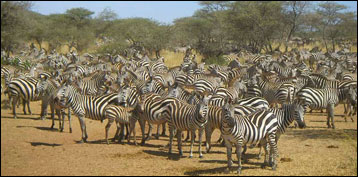Safari clothing mistakes
 Wearing white, dark,
blue, striking, or
camouflage clothing
Wearing white, dark,
blue, striking, or
camouflage clothingFine-dust air
The safari plains are dusty. White or dark clothing quickly shows the accumulated fine dust in the air that settles on your clothes. Khaki is the best color because it is dust hued.
Avoid blue
Blue attracts the tsetse fly. Its bite is painful and could inflict trypanosomiasis (sleeping sickness).
Don't alarm the animals
Large, asymmetrical patterned clothes can distress animals.
Shun camouflage clothes
You could be arrested in some countries for donning camouflage clothing if you are not a member of the military.
Dressing up "Hollywood safari" style
What not to wear
If you already bought a "safari wardrobe", you might not like what I'm going to say. Nowadays, very few safari-goers wear the clichéd big-game-hunter safari outfit. Those who do get deserved smirks from the rest.
What to wear
Today's safari dress code is comfortable, everyday clothing - the kind you would wear to a casual country-club barbecue.
Not dressing for the climate
Seasons are reversed
Unlike in the northern hemisphere, June, July and August are the coldest months in the southern hemisphere.
Climate difference
The climates of Kenya and Tanzania are significantly different than South Africa's because of geography. Kenya and Tanzania are on or near the equator while South Africa is on the southern tip of Africa.
-
Kenya and Tanzania
The Serengeti, Ngorongoro Crater, and Masai Mara game reserves can be chilly at night. The land rises as high as 2200 meters (over a mile) above sea level. Pack a light sweater and jacket as part of your safari clothing wardrobe. - South Africa
It will be even chillier at night in the cold months in the Kruger National Park. Dress in layers. You may need gloves and a hat in addition to a thick sweater, especially for the late evening and early morning.


